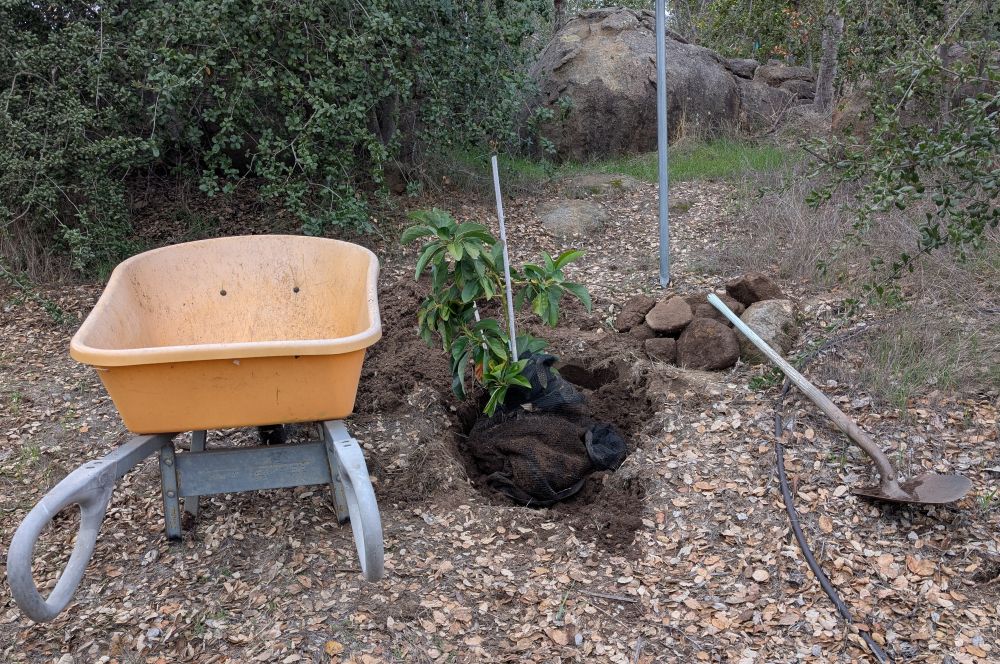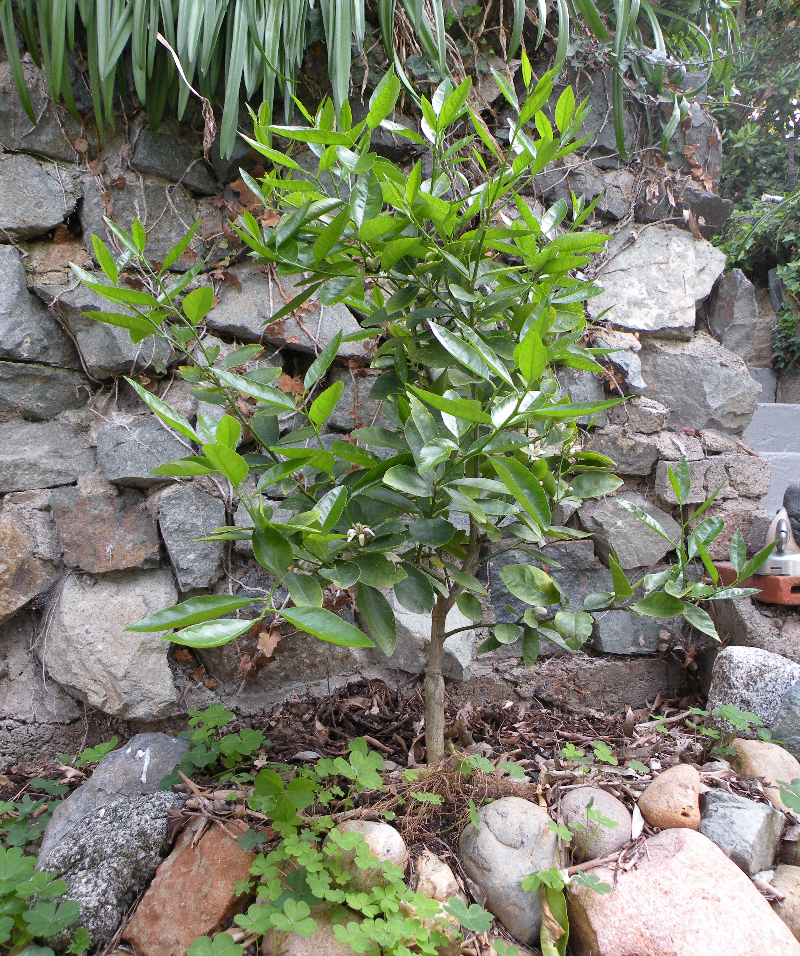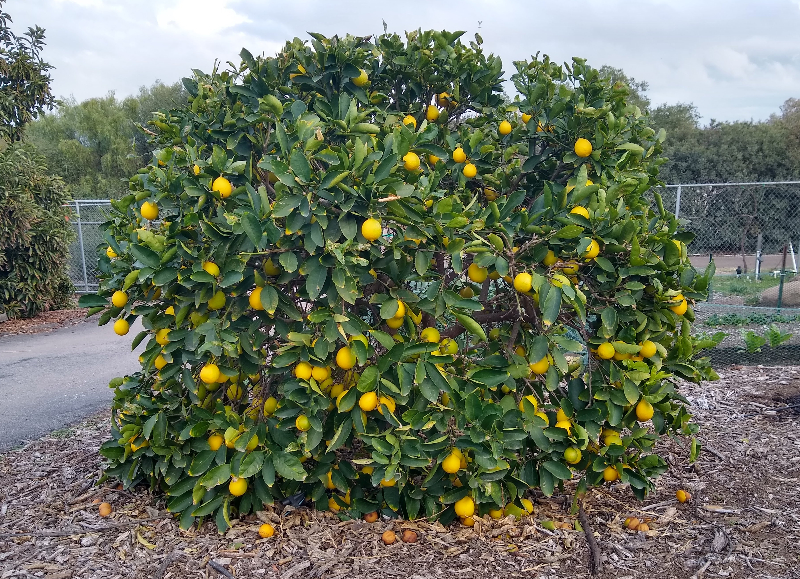I’m sure you are smarter than me and have never planted a fruit tree only to later want to move it. Maybe you learned that the spot was too cold or that the tree would get too big, or maybe you are moving to a new house and want to take the tree with you. I’ve moved fruit trees for these and many other reasons.
And through these experiences I’ve learned there are two main keys to success:
1– Transplant in late fall or winter, if possible
2– Keep intact as many roots as possible
Below I show a few real-life examples of fruit trees I’ve transplanted, and I also note some adjustments made when conditions weren’t ideal.
Deciduous fruit trees
The easiest trees to move are the deciduous ones, as long as you move them in their dormant season, that is, early winter, December and January. At this time, they have no leaves and so the roots need almost no water, and you don’t even have to transport the soil with the roots. You can “bare root” these trees by spraying the dirt off the roots with a hose as you dig them up.
Apricot
On a cloudy day eleven winters ago, I moved a Blenheim apricot tree from one side of my yard to the other. The tree had been growing vigorously in the first spot for a full year and was taller than me, but it still took the move comfortably. Here it was about three years after the transplant:

The key to moving this apricot was simply doing it in the middle of winter, when the weather was cool and the tree was dormant and without leaves to support.
Evergreen fruit trees
Fruit trees that don’t lose their leaves are harder to move because their roots are always needed to support their ever-present leaves. Still, there are times of the year when an evergreen tree is more amenable to transplanting, and that time is also late fall and winter since the weather is cool and humidity is high. The month of December is usually best because the weather is also likely to remain cool for the following few months which will allow the transplanted tree mild conditions in which to recover.
Avocados
Avocados are the most difficult tree to move because their roots are extremely brittle. Yesterday I moved a young one by keeping the rootball intact with netting (like the old ball and burlap method).

You also want to extract as many roots as possible too. Do this by first putting your shovel into the ground farther out than you think the roots might be; it can be surprising how far from the trunk roots reach.
Here is a Fuerte avocado tree that I transplanted in the winter of 2013-2014, about a decade ago now. Similarly, it had been growing in the “wrong” spot for about a year before I moved it.

It would be very hard to successfully transplant an avocado in other seasons, but I have done so with tougher evergreen trees such as citrus and mango.
Mango
This summer I transplanted a mango that had been in the ground for two years. Mangos are tough, which is why I attempted to move it in the summer.

The tree grew poorly because of root competition from nearby sumacs and oaks. So I moved it summer of 2025. After transplanting, I put shadecloth over the tree for the remainder of the summer.

Lime
In the summer of 2013, I moved to a new house and wanted to take our Bearss lime tree along.

So I dug it up and fit the rootball into a 15-gallon container for the move. At the new location (Ramona, where summers are hot) I kept the tree in the container in shade under the eaves for the rest of the summer. In the fall I planted it into its permanent spot in full sun.
The tree did not look great for a year or so, but it eventually fully recovered and showers us with more limes than we can eat.

The point is that if you must move a tree in the summer (or spring), keep it shaded after transplanting until the cool season.
How big a fruit tree can you transplant?
Can you move a big fruit tree? I can’t. Not by myself. All of the fruit trees above I moved by myself.
However, with partners and machinery there is no limit to the size of tree that can be moved. Professionals move massive trees with massive equipment every day.
No matter the tree size, guidance on the best season and techniques for transplanting remain.
Thanks for your support so I can keep the Yard Posts coming and the ads away!
Check out all of my Yard Posts here.



I just moved my 5 year old dwarf peach, last year I moved a 4 year old semi dwarf naval orange, two years ago I moved a 3 year old Saturn donut peach. All planted on the wrong side of the yard that gets shaded out from my neighbors wall of cypress. I planted them all before I knew the way the sun traveled around my property. I moved the big peach tree by root excavation. I excavated nearly all the roots with a shop vac and I think I only cut one major root because it started to go deeper than 3 feet and I already excavated about 6 feet of it in length.
The Saturn peach is doing great! The naval looks ready to explode with growth, and the dwarf peach is just about to wake up. The root excavation was time consuming, but in the end allowed me to transplant a larger more established tree.
Nice work, Clay. That does sound like it was heavy labor, but worth it.
I planted a Pakistan Mulberry tree about 3 or 4 years ago and it’s too close to my shared fence and gets slightly shaded by my neighbor’s garage. Do you think this is a candidate to be moved? It’s a vigorous grower so I couldn’t do it without machinery etc.im assuming expensive to hire the right people to do it?
Hi Mariangela,
Mulberry trees are tough like pomegranates. It’s actually hard to kill them. I think you could move your Pakistani mulberry successfully even if you ended up damaging a significant number of roots. You might want to cut back the top in proportion to the root damage, as this can give the smaller root system less top to support for a while as it rejuvenates in the new spot.
Very timely information as I was just wondering if I could move a young Wonderful pomegranate tree to a different spot. It actually was in a large plastic pot set on the ground and roots actually cracked the bottom of the pot and rooted in the ground. So I wanted to give it a better spot to grow only about 10 feet away. But will have to cut out the pot! Have you ever had to do that? Other thing is the sun this week has caused the tiny buds to start leafing and I was planning to attempt to transplant this coming week. Is ok to try for it still? (SoCal Zone 10a inland)
Hi Jen,
I think you can do it. I have transplanted small pomegranates before, and I’m going to transplant a two-year old pomegranate this week. They are very tough, resilient trees. Mine is also starting to show red buds of new leaves, but I don’t think it’s too late.
I would dig down to get as many low/deep roots as you can below the pot and then move the tree in/with the pot. Once it’s in its new planting spot, then I would cut the pot away.
I have had a couple Peruvian apple cactus (Cereus peruvianus) that grew roots through the bottom of their pots and I ultimately cut the pots away and left the plants in place and they’re happy as can be.
Thank you Greg! Going to tackle this in a couple days with my helpful husband and hopefully all goes well. Really appreciate the tips especially about cutting off the pot after moving it!
Can I move my peach tree from the ground to a large container it is a dwarf but for 2 years very little fruit and has gotten curling leaves.
Moved several young avocados and a dwarf cherry in Sept. after a few soaker rains. My thought was to allow the trees enough “good” weather (here in Humboldt that’s 60+ degrees this time of year) for roots to settle in. The ground wasn’t soft enough below 6″ – 8″ so i ended up having to pull some of the trees out. (Ouch!) I pruned those so the roots wouldn’t have as much to supply. Those i up potted to 15 gallon, 25 gallon and a big 45 gallon I didn’t do much and they all took it very well. The Dwarf Cherry I was going to toss because it got serious Peach Leaf Curl (Taphrina deformans) after applying sulfur before leafing and again before budding. But instead, jammed it into a 15 gal pot with some mostly native soil . It looked like it was dying, but with a few days of heavy rain now has come alive. Lessons learned: Transplanting is real non-stop work, have all tools, pots, soil at hand and wait until December (Thank you Greg) when the ground is wet deep enough to make the digging easier. Now i need to find something to stop the peach leaf curl.
I had significant peach leaf curl on my peach when it first started leafing out. I hadn’t used copper that year due to back surgery. I just picked the affected leaves, and to my surprise that took care of the issue. If you want a different fungicide than copper, consider a mix of water, vinegar, melaleuca and/or neem oils, and Dawn. (1 gallon of water, 4 tablespoons regular vinegar, 2 tablespoons of melaleuca oil, 1 tablespoon neem oil or just 2-3 tablespoons neem, and 1-2 tablespoons Dawn depending on if you use regular Dawn or the more concentrated version). Sorry I can’t credit the original source, I don’t recall where I read about it.